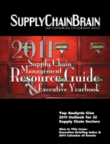
Visit Our Sponsors |
|
|
|
|
|
|
|
|
|
|
|
|
|
|
|
|
|
|
|
|
|
|
|
|
|
|
|
|
|
|
|
|
|
|
|
|
|
|
|
|
|
|
|
|
|
|
|
|
|
|
|
|
|
|
|
|
|
|
|

Analyst Insight: This past year showed us that the merger and acquisition (M&A) trends of 2009 were just the tip of the iceberg for pharmaceutical and bio-tech companies. As predicted, not only did the pharmaceutical and bio-tech industries consolidate, they brought numerous companies from complementary industries into the mix as well. The industries also started looking globally for companies that offered entry into emerging markets and international talent, and eventually learned that the challenge of integrating all of these acquisitions is not as simple as just buying another company.
-Brian Hudock, partner at Tompkins Associates
So is 2011 just an extension of 2010 or a step to the left?
In many ways, 2011 will be the same as 2010, except the size of the M&As will be smaller. Pharmaceutical companies facing uncertainty in the U.S. market due to healthcare legislation rollouts in the coming years will be looking to broaden their market reach through:
• Global expansion: Although many global markets are still small and the emerging markets have limited profit margins, the need to establish brands and presence, as well as develop cultural understanding today, is critical to long-term success.
• Diversification of offerings: Moving from one sales market into diverse healthcare markets and channels - such as generics, bio-tech, medical products, and others - will be needed to reduce the impact of price controls in specific markets.
• Portfolio expansion: Acquisition of small specialty market companies will provide companies with both full product lines and replacements for expiring patents.
With this being said, 2011 brings the challenge of creating an integrated and efficient global supply chain from the numerous parts, including logistics partners, unbalanced facilities, new customer/market requirements and the multiple governmental regulatory challenges emerging markets present. This means rationalizing a large number of contracts and providers that have both the local expertise and the global network to move product seamlessly. These steps will include:
1. Standardization of IT systems;
2. Logistics provider consolidation;
3. Production relocation and balancing;
4. Market expansion and product customization; and
5. Centralization of supply chain control while maintaining local expertise.
The last challenge for 2011, as the diversity of product lines expands, is that pharmaceutical organizations must change the way they distribute in order to manage costs in lower margin businesses, while increasing security in others.
The Outlook
Pharmaceutical and bio-tech organizations are becoming more and more a part of a unified industry that spans global borders, and in 2011, these companies will have to determine how to make each area work together or face the challenge of managing multiple non-optimized supply chain units. Of course, each new acquisition - whether already acquired, identified, or a future target - must be part of the strategy established in the near future to ensure that the strategy is flexible, expandable and globally dynamic.
RELATED CONTENT
RELATED VIDEOS
Timely, incisive articles delivered directly to your inbox.







